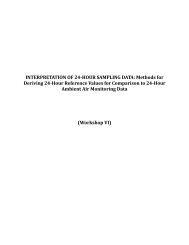Appendices - Alliance for Risk Assessment
Appendices - Alliance for Risk Assessment
Appendices - Alliance for Risk Assessment
Create successful ePaper yourself
Turn your PDF publications into a flip-book with our unique Google optimized e-Paper software.
Attachment 2 – Sample Compiled Comments and Response on a Case Study<br />
<strong>Assessment</strong> of Low-Dose Dose-Response Relationships<br />
(Non-linear or Linear) <strong>for</strong> Genotoxicity, Focused on<br />
Induction of Mutations & Clastogenic Effects (Multiple<br />
chemicals)<br />
Presented by: Pottenger, L.;<br />
Moore, M.<br />
Co-authors: Zeiger, E.;<br />
Zhou, T.<br />
Workshop 2 panel comments: The panel supported carrying this method <strong>for</strong>ward. Panel<br />
members noted that a key contribution of the case study is in articulating a MOA <strong>for</strong> gene<br />
mutation, and in prompting the risk assessment community to think about mutation in the context<br />
of key events. The panel recommended that that MOA framework be used to highlight a critical<br />
evaluation of the underlying biology, and that <strong>for</strong>mal statistical tests specifically comparing the<br />
tumor dose response slope with that of the mutation dose response slope, would enhance the case<br />
study. A panel member noted that in<strong>for</strong>mation on the background incidence of the various<br />
measured endpoints could be used to address the issue of additivity to background.<br />
Author changes: The changes made to the full case study are highlighted in yellow. When<br />
sections are new or substantially revised, the header is highlighted in the table of contents and<br />
the text. Smaller changes in the text are highlighted in the text itself. The primary change was<br />
the addition of a preliminary analysis of the MOA <strong>for</strong> mutation conducted <strong>for</strong> MMS/MNU and<br />
EMS/ENU, based on review of selected publications and the MOA <strong>for</strong> mutation of Pottenger and<br />
Gollapudi (2010) (see pp 11-13 in Main case study document and Appendix E).<br />
Workshop 3 panel comments: In Workshop 2, the panel recommended that the authors enhance<br />
the study by conducting a MOA analysis <strong>for</strong> mutation and by conducting <strong>for</strong>mal statistical tests<br />
specifically comparing the tumor dose-response slope with that of the mutation dose-response<br />
slope. In the MOA analysis, focusing on recent data, the authors found supporting data <strong>for</strong> some<br />
key events, but there was a lack of data <strong>for</strong> other events. A panel member suggested that in the<br />
future, it would be important to match the low-dose response <strong>for</strong> mutations with the doseresponse<br />
assessment <strong>for</strong> tumors. However, the authors noted that there might not be enough<br />
low-dose data, and the panel agreed that this is an important point to stress in the case study<br />
write-up. Panel members noted it is important to be clear about where data exist and where they<br />
do not; a qualitative VOI analysis could be conducted related to the data gaps. The panel<br />
encouraged the study authors to think about identifying the critical data gaps and identifying<br />
what is driving the process. A panel member suggested that the authors think mechanistically<br />
about whether a hockey stick dose-response shape is due to a fundamental biological<br />
nonlinearity or due to background noise.





